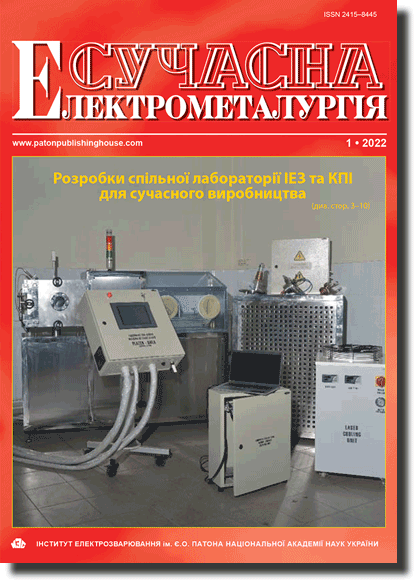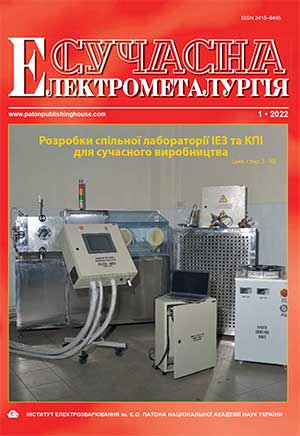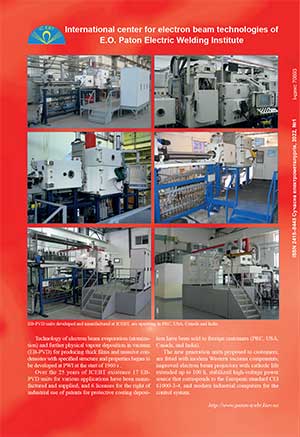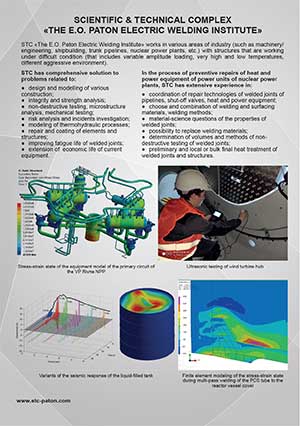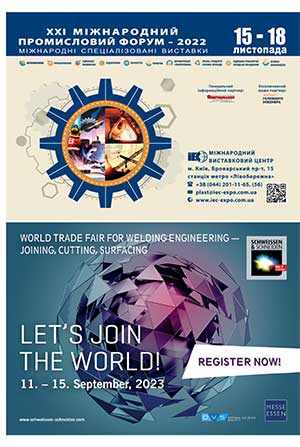| 2022 №01 (03) |
DOI of Article 10.37434/sem2022.01.04 |
2022 №01 (05) |
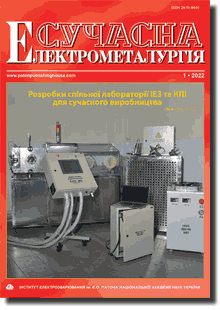
"Suchasna Elektrometallurgiya" (Electrometallurgy Today), 2022, #1, 34-39 pages
Electroslag melting in an open mould of ingots from sheet scrap wastes of titanium VT1-0
D.I. Bilonik1, О.V. Ovchynnykov1, I.M. Bilonik1, O.Ye. Kapustian1, S.A. Shumikin1, D.V. Raspornia2, Yu.M. Savonov1
1Zaporizhzhia Polytechnic National University. 64 Zhukovsky Str, 69063, Zaporizhzhia, Ukraine. E-mail: aek@zntu.edu.ua
2O.O. Galkin Donetsk Institute for Physics and Engineering of the National Academy of Sciences of Ukraine. 46 Nauki Ave., 03680, Kyiv, Ukraine
Abstract
The expediency of conducting studies of the electroslag process in an open mould to produce titanium ingots using consumable electrodes made from conditioned wastes of VT1-0 titanium sheets was substantiated. The results of the study of the produced titanium ingots of 85 mm diameter and 90×90 mm cross section are presented. Smelting was performed in electroslag installation A-550, flux was CaF2 (100 %). To prevent critical heating of the consumable titanium electrodes and oxidation of their surface, a sliding current supply was installed on the upper flange of the mould. The optimal technological parameters of electroslag smelting were established on the basis of analysis of the shape and determination of the depth of the metal pool, which was fixed with tungsten chips at the deposition rate of 0.9⋅10‒2 kg/s; 1.1⋅10‒2 kg/s and 1.7⋅10‒2 kg/s. Surface condition and chemical composition were evaluated on ingots produced with an optimal deposition rate of (0.9⋅10‒2 kg/s). The ingot surface was smooth, without any constrictions or corrugations. Chemical composition of ingots, wt.%: Ti — base; C — 0.024; Fe — 0.06; Si — 0.05; O2 — 0.25; N2 — 0.058; H2 — 0.0016 meets the requirements of GOST 19807‒91 for unalloyed VT1-0 titanium, except for higher oxygen and nitrogen content; and fully complies with the chemical composition of VT1-2 grade and a number of undoped titanium materials from foreign manufacturers. Performed studies have shown the fundamental possibility of using electroslag smelting technology in an open mould with a sliding current supply to produce ingots from sheet wastes of VT1-0 titanium. Ref. 28, Table 1, Fig. 4.
Keywords: VT1-0 titanium; electroslag process; semi-finished product; flux, consumable electrode; chemical composition
Received 29.11.2021
References
1. Aleksandrov, V.K., Anoshkin, N.F., Bochvar, H.A. (1979) Semi-finished products from titanium alloys. Moskow, Metallurgiya [in Russian].2. (2019) Catalog of products and services of the research and production complex "Titanium Alloys". St.-Petersburg, TsNII «Prometei» [in Russian].
3. Kapustian, A.E., Ovchinnikov, A.V., Kovalenko, T.A., Shevchenko, V.H. (2016) Producing of semi-finished titanium alloys for aerospace engineering. Aviatsionno-Kosmicheskaya Tekhnika i Tekhnologiya, 134(7), 107-116 [in Russian].
4. Kapustian, A.E. (2015) Producing of long-length semi-finished products from sintered titanium alloys by friction welding. Avtomatich. Svarka, 3, 55-59 [in Russian]. https://doi.org/10.15407/tpwj2015.04.07
5. Skrebtsov, A.A., Ovchinnikov, A.V., Kapustian, A.E. (2012) Investigation of mechanical properties of sintered titanium alloy welded joints. Visnyk SevNTU. Seriya: Mekhanika, Energetyka, Ekologiya, 132, 14-17 [in Russian].
6. Ovchinnikov, A.V., Davydov, S.Y., Shvartsman, L.Ya. (2007) Advanced technologies for production of titanium alloys. Novi Materialy i Tekhnologii v Metalurgii ta Mashynobuduvanni, 2, 56-60 [in Russian].
7. Pavlov, V.A. (2010) Pressure treatment of powdered non-ferrous metals. Zaporozhie, Motor-Sich [in Russian].
8. Kapustian, A.E., Ovchinnikov, A.V., Pavlov, V.V. et al. (2015) Influence of pressing and sintering modes on the titanium product porosity. Obrabotka Materialov Davleniem, 41(2), 22-31 [in Russian].
9. Ovchinnikov, A.V. (2013) Materials science bases of restoration of products from complex titanium alloys modified with submicrocrystalline materials: Syn. of Thesis for Dr. of Tech. Sci. Degree. Zaporozhie [in Russian].
10. Giser, E.Sh., Chekotilo, L.V., Beletsky, V.M. (1977) Electroslag casting of billets from high-strength titanium alloy VT22. Problemy Spets. Elektrometallurgii, 6, 21-23 [in Russian].
11. Gurevich, S.M., Didkovsky, V.P., Novikov, Yu.K. (1963) Electroslag melting of titanium alloys. Avtomatich. Svarka, 10, 37-42 [in Russian].
12. Armantrout, C.E., Ausmus, S.L., Beall, R.A., Dunham, I.T. (1999) Properties of electroslag and vacuum arc melted titanium. Titanium`99: Sci. and Technology, 9, 109-117.
13. Nefziger, R.Kh. (1971) Slags for electroslag melting of titanium and melting modes. In: Electroslag Remelting. Kiev, Naukova Dumka, 202-218 [in Russian].
14. Medovar, L.B., Saenko, V.Ya. (2006) Electroslag remelting of titanium: opportunities and prospects. Elektrometallurgiya, 8, 3-8 [in Russian].
15. Ryabtsev, A.D., Troyansky, A.A. (2001) Production of ingots of titanium, chromium and alloys based on them in chamber electroslag furnaces under "active" metal-containing fluxes. Problemy Spets. Elektrometallurgii, 4, 6-9 [in Russian].
16. Protokovilov, Y.V., Nazarchuk, A.T., Petrov, D.A., Porokhonko, V.B. (2018) Technological and metallurgical peculiarities of melting the titanium alloy ingots in chamber-type electroslag furnaces. Suchasna Elektrometal., 2, 45-50. [in Russian]. https://doi.org/10.15407/sem2018.02.06
17. Paton, B.E., Medovar, L.B., Saenko, V.Ya. (1994) Remelting of titanium spongy consumable electrodes by ESR and ASR methods. Problemy Spets. Elektrometallurgii, 3-4, 7-11 [in Russian].
18. Medovar, L.B., Saenko, V.Ya. and Ryabinin, V.A. (2010) Selecting fluxes for arc slag remelting in production of titanium ingots. Advances of Electrometallurgy, 1, 5-9.
19. (1992) GOST 19807-91. Titanium and titanium wrought alloys. Grades [in Russian].
20. Ryabtsev, A.D., Davydov, S.Y., Troyansky, A.A. (2007) Production of increased strength titanium by its doping with oxygen in the process of chamber electroslag remelting. Advances in Electrometallurgy, 3, 2-5.
21. Ovchinnikov, A.V., Davydov, S.Y., Shevchenko, V.H. (2007) Influence of alloying by oxygen of titanium sponge on the structure and mechanical properties of cast titanium. In: Proc. of Int. Conf. on Ti-2007 CIS (Yalta, Ukraine, 15-18 April, 2007), 170-173.
22. Glazova, V.V., Kornilov, I.I., Modestova, V.N., Tomashov, N.D. (1965) Corrosion behavior of titanium-oxygen system alloys in sulfuric acid solutions. Fizicheskaya Khimiya, 165(1), 136-139 [in Russian].
23. Kolachev, B.A., Polkin, I.S.,Talalaev, V.D. (2000) Titanium alloys of different countries. Moskow, VILS [in Russian].
24. Ilyin, A.A., Kolachev, B.A., Polkin, I.S. (2009) Titanium alloys. Composition, structure, properties: Refer. Book. Moskow, VILS-MATI [in Russian].
25. Leokha, F.L., Ratiev, S.N. (2012) Modern methods of producing oxygen-doped titanium alloys. Nauk. Pratsi DNTU. Seriya: Metalurgiya, 1-2, 85-94 [in Russian].
26. (2019) ASTM B348/B348M-19. Standard Specification for Titanium and Titanium Alloy Bars and Billets.
27. (2017) ASTM B367-13. Standard Specification for Titanium and Titanium Alloy Castings.
28. Klyuev, M.M., Kablunovsky, D.F. (1969) Metallurgy of electroslag remelting. Moskow, Metallurgiya [in Russian].
Advertising in this issue:
The cost of subscription/purchase order journals or individual articles
| Journal/Currency | Annual Set | 1 issue printed |
1 issue |
one article |
| TPWJ/USD | 384 $ | 32 $ | 26 $ | 13 $ |
| TPWJ/EUR | 348 € | 29 € | 24 € | 12 € |
| TPWJ/UAH | 7200 UAH | 600 UAH | 600 UAH | 280 UAH |
| AS/UAH | 1800 UAH | 300 UAH | 300 UAH | 150 UAH |
| AS/USD | 192 $ | 32 $ | 26 $ | 13 $ |
| AS/EUR | 180 € | 30 € | 25 € | 12 € |
| SEM/UAH | 1200 UAH | 300 UAH | 300 UAH | 150 UAH |
| SEM/USD | 128 $ | 32 $ | 26 $ | 13 $ |
| SEM/EUR | 120 € | 30 € | 25 € | 12 € |
| TDNK/UAH | 1200 UAH | 300 UAH | 300 UAH | 150 UAH |
| TDNK/USD | 128 $ | 32 $ | 26 $ | 13 $ |
| TDNK/EUR | 120 € | 30 € | 25 € | 15 € |
AS = «Automatic Welding» - 6 issues per year;
TPWJ = «PATON WELDING JOURNAL» - 12 issues per year;
SEM = «Electrometallurgy Today» - 4 issues per year;
TDNK = «Technical Diagnostics and Non-Destructive Testing» - 4 issues per year.





